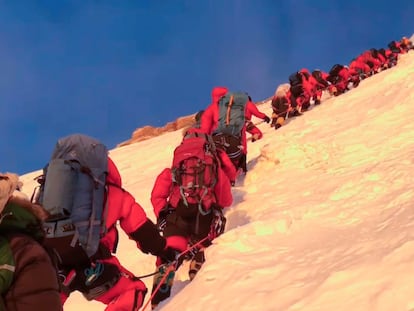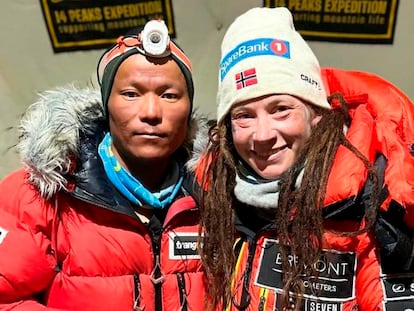The game of mountaineering claims the life of the legendary Dmitry Golovchenko
The Russian climber died on Gasherbrum IV in circumstances that have not yet been clarified by his loyal teammate and fellow Piolet d’Or winner Sergey Nilov

The game ends like this, in brutal fashion: a man at the limit of his physical and psychological endurance, searching madly for the remains of his friend on the glacier at the foot of a fearsome mountain: the 7,925m Gasherbrum IV in Pakistan. Eventually, Sergey Nilov finds him, wraps him in the fabric of his tent, and continues to descend, like a specter, toward his base camp. Unfathomable loneliness manifests itself and accompanies him like a sinister shadow. Incomprehension is mixed with the most painful sadness. Dmitry Golovchencko’s body may never be recovered and it is almost certain that Nilov will never find a climbing partner like the one he has just lost, a friend with whom he had spent years perpetuating his childhood, playing at climbing the most intimidating mountains in existence. In 1976, after scaling Changabang, Peter Boardman said that no mountain is insurmountable if you really want it, a credo shared by Nilov and Golovchenko, two climbers who didn’t need to look at the weather report before attempting a wall. Their motto was: if you wait for good weather, you will never be a mountaineer. That’s why they both had two Piolets d’Or, the highest award in mountaineering. Those were happy times. Each triumph was joyful and fed their voracity, taking them from one place to another, walking ever more on an invisible edge.
Thus, enduring wind, snow, and practically zero visibility, the pair had been on the virgin southeast ridge of Gasherbrum IV since August 21. Groping their way forward inch by inch. They sent short messages via satellite phone to conserve battery power: “Bad weather. Windy. Snow. Thinking about how not to eat.” In fact, both climbers knew perfectly well how to ration the provisions they carried so they would last as long as possible. In 2019, they spent 18 days on the Jannu, barely eating anything during the final week, after climbing the east face and completing an epic descent down the south slope that led them to send a self-deprecating message: “We’re not kidding: we want to go down!” Only their vast experience allowed them to come out alive and smiling.
But on the southeast ridge of Gasherbrum IV, nothing went smoothly. Reaching the foot of the ridge was a feat in itself, a complicated route through a labyrinthine and treacherous glacier and, finally, a bit of peace to pitch a tent at 7,000 meters and face the most technical part of the route. But bad weather dogged the Russian duo from the outset. The go-to website in the world of Russian mountaineering, Mountain.ru, a sponsor of the expedition, posted daily messages with the same militancy with which it denounced the invasion of Ukraine a year ago, placing itself in a complicated and threatening situation.
Nilov recovering in Islamabad
Mountain.ru explained a few days ago that they had reached an altitude of 7,580 meters, but the details of the accident that took Golovchencko’s life remain undisclosed, although it apparently occurred while they were trying to reach the summit and not during their descent, as initially assumed. Although Nilov has been treated in a hospital in Islamabad, where he is recovering from extreme fatigue and serious frostbite in both feet, the survivor is not strong enough to explain the details of the tragedy and his subsequent nightmarish solo descent. Only an exceptional mountaineer can remain alive after descending such a dangerous route on his own. In fact, their original plan was not to come back down via the ascent route, but to seek gentler terrain on the other side of the mountain.
Gasherbrum IV has only been ascended 17 times and those who take on the mountain also face the weight of history, of the fabled names of those that went before. In 1958, the incomparable Walter Bonatti and his Italian compatriot Carlo Mauri made the first ascent, in this case on the northeast ridge, as part of an expedition led by the no less legendary Ricardo Cassin. If their climb was a remarkable feat, the epic achievement of the Pole Wojtek Kurtyka and the Austrian Robert Schauer in 1985 will be forever remembered as the wildest, most committed, and visionary activity ever undertaken on Gasherbrum IV: both climbed the west face, known as the glowing wall, in strict and minimalist alpine style, enduring periods of climbing in which a fall would have killed them both, spending a total of eight nights on the wall. To say, as is usual, that they went beyond any acceptable physical and psychological limits is to say nothing at all.
Nilov and Golovchenko intended, in turn, to etch their story into the history of a mountain that only accepts surnames with pedigree. Yes, they were going to suffer. They took that for granted. No, the bad weather was not going to force them to give up. Yes, the game of mountaineering is not played if one is not clear about one’s obligations, or the rules. In the highest altitudes, a withdrawal is not a defeat. Only death is. And then, the game loses all trace of playful experience.
Sign up for our weekly newsletter to get more English-language news coverage from EL PAÍS USA Edition
Tu suscripción se está usando en otro dispositivo
¿Quieres añadir otro usuario a tu suscripción?
Si continúas leyendo en este dispositivo, no se podrá leer en el otro.
FlechaTu suscripción se está usando en otro dispositivo y solo puedes acceder a EL PAÍS desde un dispositivo a la vez.
Si quieres compartir tu cuenta, cambia tu suscripción a la modalidad Premium, así podrás añadir otro usuario. Cada uno accederá con su propia cuenta de email, lo que os permitirá personalizar vuestra experiencia en EL PAÍS.
¿Tienes una suscripción de empresa? Accede aquí para contratar más cuentas.
En el caso de no saber quién está usando tu cuenta, te recomendamos cambiar tu contraseña aquí.
Si decides continuar compartiendo tu cuenta, este mensaje se mostrará en tu dispositivo y en el de la otra persona que está usando tu cuenta de forma indefinida, afectando a tu experiencia de lectura. Puedes consultar aquí los términos y condiciones de la suscripción digital.
More information
Archived In
Últimas noticias
Welcome to the post-religion era: The idea of Christianity as the absolute truth has become obsolete
‘I thought you would like it’: The risky sexual practice popularized by TV shows and TikTok
The digitalization of tourism: ‘They promise experiences and gave us the worst possible one’
Mexican peso defies uncertainty with forecasts of a new period of stability in 2026
Most viewed
- Sinaloa Cartel war is taking its toll on Los Chapitos
- Oona Chaplin: ‘I told James Cameron that I was living in a treehouse and starting a permaculture project with a friend’
- Reinhard Genzel, Nobel laureate in physics: ‘One-minute videos will never give you the truth’
- Why the price of coffee has skyrocketed: from Brazilian plantations to specialty coffee houses
- Silver prices are going crazy: This is what’s fueling the rally











































